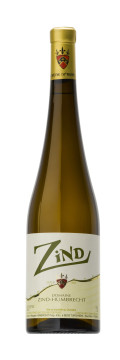
Technical presentation
| Bottling : | March 2015 |
|---|---|
| Acquired alcohol : | 13.5° |
| Residual sugar : | 3.1 g/l |
| Total acidity : | 4.1 g/l H2SO4 / (6.3 g/l Tartrique) |
| pH : | 3.1 |
| Yield : | 45 hl/ha |
| Optimum tasting : | 2016-2028 |
| Average age of vines : | 24 years |
| Terroir : | Clos Windsbuhl |
| Sweetness index : | 1 |
| Soil : | Muschelkalk calcareous |
Description of the wine Zind 2013
It seems that both the Auxerrois (35%) and Chardonnay (65%) grapes decided to have a break after two generous vintages. The stony Muschelkalk (seashell limestone) soil of the Windsbuhl produced lower yields in 2013, packing this Zind wine with lots of character and zesty acidity. The consequence was a long fermentation and we feared that it would keep some significant residual sweetness. However, having been able to harvest the grapes at perfect desired ripeness and very healthy, the wild yeast managed to ferment the wine dry.

Tasting notes
03/2015 : Delicate vanilla and spices on the nose (no new oak used!) and then opens up to more herbal, citrus aromatics. There is always a limestone mineral signature in the wines originating from this vineyard, easy to recognize on both nose and palate. The palate has a delicate mid power structure that opens up quickly. There is a juicy saline acidity increasing the finish and making this wine perfect with seafood.

The Clos Windsbuhl of Hunawihr
The altitude of the vineyard coupled with Hunawihr’s tardy climate means that the Clos Windsbuhl is often one of the last of our vineyards to be harvested. This explains the aromatic quality of the Clos’ wines and the consistent balance of acidity, a guarantee of good ageing. Although often harvested late, the Windsbuhl grapes are only rarely botryitized, doubtless due to the altitude of the vineyard, but nevertheless often reach high levels of maturity.